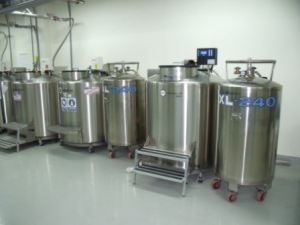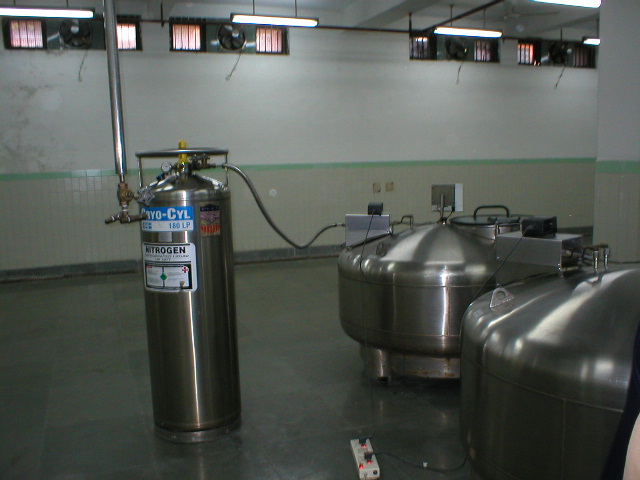Cryo bank
|
|
Page compiled by: Bioversity International/ILRI, Addis Ababa, Ethiopia (Alexandra Jorge); ILRI, Addis Ababa, Ethiopia (Jean Hanson); Katholieke Universiteit Leuven, Belgium (Bart Panis).
Storage of germplasm using cryopreservation
Cryopreservation is becoming more widely used for long-term storage of seeds and in vitro cultures and is the method of choice for ensuring cost-effective and safe, long-term storage of genetic resources of species which have recalcitrant seeds or are vegetatively propagated. Storage is usually in liquid nitrogen (-196°C), whereby all metabolic processes and cell divisions are arrested.
|
|
Orthodox seeds
Seed conservation of orthodox seeds in liquid nitrogen at -196°C has been successfully achieved for a wide range of crop species. Once stored in liquid nitrogen, seeds can be kept for unlimited periods. Seed storage in base collections at -20°C is addressed under the seed conservation page.
Dessication intolerant seeds
Conservation of seeds with non-orthodox behaviour and those that are desiccation intolerant allows seeds which were previously considered as short-lived to be stored for long periods at ultra-low temperatures. This has been achieved for several species, including Citrus, coconut, coffee and areca nut through controlled desiccation of whole seeds, excised embryos or embryonic axes followed by cryopreservation.
Tissues
Preservation of dormant buds and in vitro cultures, including apical meristems and somatic embryos, at cryogenic temperatures is considered as the only suitable alternative that can ensure the long-term security of stored germplasm. Once stored in liquid nitrogen, tissues can be kept for unlimited periods. It is most appropriate for base collections of long-term storage
Advantages
The ultra low temperatures used during cryopreservation virtually stop metabolic deterioration during storage of tissues and seeds and therefore extends their longevity during long-term storage. The material is protected from contamination and very little maintenance is needed. The method relies on liquid nitrogen in self contained tanks and is not dependent on refrigeration or a constant electricity supply. It is also cost effective because of the reduced energy costs, limited space requirements and because there is no need for regular regeneration of plant material.
Disadvantages
There is no generic protocol which could be applicable to all types of explants. Therefore, each successive step of a cryopreservation protocol needs to be optimized for any new plant material to be cryopreserved.
Not all orthodox seeds are suitable for cryopreservation and hard seeded legume seeds may crack or shatter and some seeds with high oil contents loose viability. It is also a very costly method to store large seeds such as maize and beans.
Practical considerations
Until fifteen years ago, cryopreservation protocols for plant tissues were mainly based on slow freezing in the presence of cryoprotective mixtures containing dimethyl sulphoxide, sugars, glycerol and/or proline. Slow freezing results in a freeze-dehydration, leaving less water in the cells to form lethal ice crystals upon exposure to extreme low temperatures. While this method is very convenient for many plant tissues, especially undifferentiated callus or suspension cells, new methods had to be developed for plant species and tissues that were unresponsive.
During the last two decades, several new cryopreservation procedures have been established. Among them, the protocols termed encapsulation/dehydration, encapsulation/vitrification and vitrification. All these new techniques involve the extraction of freezable water from the tissue cells before cooling. As a result vitrification of internal solutes takes place during cooling. Vitrification can be defined as the transition of water directly from the liquid phase into an amorphous phase or glass, whilst avoiding the formation of lethal crystalline ice The vitrification technique involves a treatment with cryoprotective loading solutions followed by dehydration with highly concentrated vitrification solutions. A modification of this technique, that further reduces the chance for lethal ice-crystal formation through the application of ultra-fast cooling and rewarming rates called “droplet vitrification” has now been developed for different vegetatively propagated tropical crops.
Each species requires specific protocols that must be carefully followed for preparation of samples to ensure maximum survival.
General considerations
- Tissues and recalcitrant seeds generally cannot be thawed and refrozen without damage.
- Orthodox seeds and pollen behave differently and can usually be thawed and refrozen
- Transfer cryopreserved material quickly between vessels to avoid rewarming.
- Ensure good air circulation in the room where LN storage tanks are placed because nitrogen gas is constantly boiling from the tanks. Oxygen monitors should be placed around the room for detection of oxygen content of the air.
- Use emergency fans that are triggered by the oxygen monitors or emergency buttons to increase air exchange in case of build up of nitrogen gas
|
|
Storage containers
-
Storage container will vary with the size of the seeds or tissues. Store seeds and tissues in 1.8 and 2.0 ml cryogenic vials for cryopreservation:
- For meristems and shoot tips, 10-25 tissues can be placed in one vial;
- For small seeds from 1500 to 3000 can be placed in one vial;
- Larger vials will be needed for storage of larger seeded orthodox seeds;
- Place multiple vials into aluminum cans or metal boxes for storage.
-
Liquid nitrogen storage containers vary with tissue and size of collection:
- Small 20-30 liter tanks with no vapor phase for direct tissue storage.
- Five-foot-diameter steel tanks that allow a vapour phase for seed storage.
- Use well insulated containers to reduce loss of liquid nitrogen. Containers with narrow necks reduce loss of liquid nitrogen but are inconvenient for access.
- Use an alarm system to indicate low liquid nitrogen levels.
- Top up storage dewars once in a week.
Storage temperature
Cryogenic vials may be stored directly in the liquid nitrogen at -196°C or suspended in trays within the vapour phase of the liquid nitrogen at -160°C
Replication
The number of replications depends on the survival, crop type, speed of propagation, stability in culture and material available for storage. Probalistic tolls have been developed to assist in the establishment and management of cryopreserved collections (see Dussert et al. 2003)
Specific crop protocols
Storage protocols have been developed for several important vegetatively propagated crops, including banana, cassava, potato, sweet potato and yam.
Banana - Cryopreservation of Musa germplasm
Cassava - http://webapp.ciat.cgiar.org/asia_cassava/pdf/proceedings_workshop_02/136.pdf
Potato - http://www.cipotato.org/csd/Materials/Tissue/Capitulo4.pdf
Sweet potato - http://www.cipotato.org/csd/materials/Sweetpotato%202-4.asp
Yam - http://www.ejbiotechnology.info/content/vol1/issue3/full/2/bip/
References and further reading
Bajaj YPS, editor. 1995. Cryopreservation of Plant Germplasm I. Biotechnology in Agriculture and Forestry, Vol. 32. Springer, Berlin, Germany.
Batugal P, Ramanatha Rao V, Oliver J, editors. 2005. Coconut genetic resources, International Board for Plant Genetic Resources, Rome, Italy.779 p. Available here.
Benson EE. 1999. Plant Conservation Biotechnology, pp. 139–154. Taylor & Francis, London.
Benson EE, Harding K, Debouck D, Dumet D, Escobar R, Mafla G, Panis B, Panta A, Tay D, Van den houwe I, Roux N. 2011. Refinement and standardization of storage procedures for clonal crops - Global Public Goods Phase 2: Part I. Project landscape and general status of clonal crop in vitro conservation technologies. System-wide Genetic Resources Programme, Rome, Italy. Available here (2.5 MB).
Benson EE, Harding K, Debouck D, Dumet D, Escobar R, Mafla G, Panis B, Panta A, Tay D, Van den houwe I, Roux N. 2011. Refinement and standardization of storage procedures for clonal crops - Global Public Goods Phase 2: Part II. Status of in vitro conservation technologies for: Andean root and tuber crops, cassava, Musa, potato, sweet potato and yam. System-wide Genetic Resources Programme, Rome, Italy. Available as full size PDF (9 MB) and light version (3.5 MB).
Benson EE, Harding K, Debouck D, Dumet D, Escobar R, Mafla G, Panis B, Panta A, Tay D, Van den houwe I, Roux N. 2011. Refinement and standardization of storage procedures for clonal crops - Global Public Goods Phase 2: Part III. Multi-crop guidelines for developing in vitro conservation best practices for clonal crops. System-wide Genetic Resources Programme, Rome, Italy. Available here (4.5 MB).
Chandel KPS, Pandey R, Paroda RS, Arora RK. 1991. Plant genetic resources conservation: recent approaches. Plant genetic resources: conservation and management. Concepts and approaches. International Board for Plant Genetic Resources New Delhi (India). p. 247-272.
Chaudhury R, Pandey R, Malik SK, Bhag Mal, editors. 2003. In vitro conservation and cryopreservation of tropical fruit species. Proceedings of the Regional Training Course on In Vitro Conservation of Tropical Fruit Genetic Resources, organized at the National Bureau of Plant Genetic Resources (NBPGR), New Delhi, India, 4-16 February 2002. 293 p.
Dussert S, Engelmann F, Noirot M. 2003. Development of probabilistic tools to assist in the establishment and management of cryopreserved plant germplasm collections. Cryoletters 24:149-160.
Engelmann F. 2004. Plant cryopreservation: Progress and prospects. In vitro Cellular and Developmental Biology plant 40:427-433.
Engelmann F, Dulloo ME, Astorga C, Dussert S, Anthony F, editors. 2007. Conserving coffee genetic resources: complementary strategies for ex situ conservation of coffee (Coffea arabica L.) genetic resources. A case study in CATIE, Costa Rica. Topical Reviews in Agricultural Biodiversity Rome (Italy). 61 p.
Engelmann F, Takagi H, editors. 2000. Cryopreservation of Tropical Plant Germplasm – Current Research Progress and Applications. International Plant Genetic Resources Institute, Rome, Italy.
FAO. 2013. Genebank standards for plant genetic resources for food and agriculture. Food and Agriculture Organization of the United Nations, Rome. Available in English, Spanish, French, Arabic, Russian and Chinese here.
Gonzalez-Arnao MT, Engelmann F. 2006. Cryopreservation of plant germplasm using the encapsulation-dehyrdation technique:review and case study on sugarcane. Cryoletters 27:155-168.
Harding K. 2004. Genetic integrity of cryopreserved plant cells: A review. CryoLetters 25:3-22.
Iwanaga M. 1994. Cassava genetic resources management at CIAT International network for cassava genetic resources. Report of the first meeting of the International Network for Cassava Genetic Resources held at CIAT, Cali, Colombia, 18-22 August 1992. International Crop Network Series no. 10. p. 77-86.
Kartha KK, editor. 1985. Plant Cryopreservation. CRC Press, Boca Raton, Florida, USA.
Panis B, Lambardi M, 2006. Status of cryopreservation technologies in plants (crops and forest trees). In: Ruane J, Sonnino A, editors. The role of biotechnology in exploring and protecting agricultural genetic resources. Food and Agriculture Organization of the United Nations, Rome, Italy: 61-78. Available from: http://www.fao.org/Biotech/docs/panis.pdf Date accessed: 18 April 2011.
Panis B, Piette B, Swennen R. 2005. Droplet vitrification of apical meristems: a cryopreservation protocol applicable to all Musaceae. Plant Science 168:45-55.
Panis B, Thinh NT. 2001. Cryopreservation of Musa germplasm. INIBAP Technical Guideline 5 (J.V. Escalant and S. Sharrock, eds). International Network for the Improvement of Banana and Plantain, Montpellier, France. Available here.
Raja K, Palanisamy V, Selvaraju P. 2003. Desiccation and cryopreservation of recalcitrant arecanut (Areca catechu L.) embryos. Plant Genetic Resources Newsletter 133:16-18. Available from: http://www2.bioversityinternational.org/publications/pgrnewsletter/article.asp?lang=en&id_article=96&id_issue=133 Date accessed: 18 April 2011.
Pritchard HW. 2007. Cryopreservation of desiccation tolerant seeds. Methods in molecular biology, 368:185-201.
Razdan MK, editor. 1997. Conservation of Plant Genetic Resources In Vitro. Oxford and IBH Publishing Co. Pvt. Ltd., India.
Reed BM. 2008. Plant Cryopreservation: A practical guide. Springer Science and Business Media, USA. 513 pp.
Reed BM, Engelmann F, Dulloo ME, Engels JMM. 2004. Technical guidelines for the management of field and in vitro germplasm collections. IPGRI Handbook for Genebanks No.7. IPGRI, Rome, Italy. Available here.
Santos IRI, Stushnoff C. 2002. Cryopreservation of embryonic axes of Citrus species by encapsulation-dehydration. Plant Genetic Resources Newsletter 131:36-41. Available from: http://www2.bioversityinternational.org/publications/pgrnewsletter/article.asp?lang=en&id_article=71&id_issue=131 Date accessed: 18 April 2011.
Stanwood PC, Bass LN. 1981. Seed germplasm preservation using liquid nitrogen. Seed Science and Technology 9, 423-437.
Tay DCS, Liu CR. 1992. Using hard agar medium and grooved tubes for the distribution of sweet potato tissue culture. Plant Genetic Resources Newsletter 88/89:23-25.
Towill LE, Bajaj YPS, editors. 2002. Cryopreservation of Plant Germplasm II. Biotechnology in Agriculture and Forestry, Vol. 50. Springer, Berlin.
Withers LA, Paroda RS, Arora RK. 1991. Biotechnology and plant genetic resources conservation. Plant genetic resources: conservation and management. Concepts and approaches. International Board for Plant Genetic Resources, New Delhi (India). p. 273-297.
Comments
- No comments found









Leave your comments
Post comment as a guest